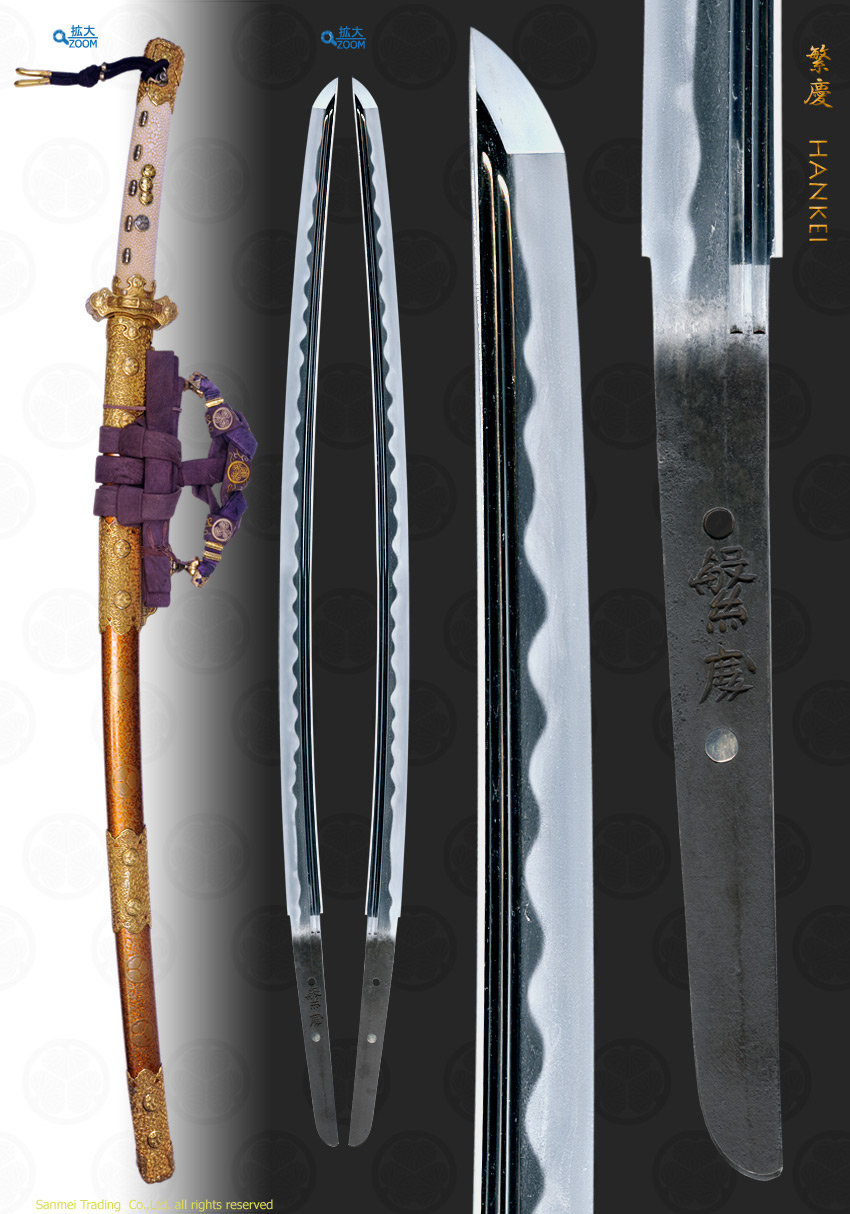with) Gold Pearl of Inlay AOI crest Makie scabbard Efu-style Tachi Koshirae
reported in the books of
Kanto Hibi-sho & Token-Bijutsu vol.177
Length of cutting edge70.0cm Curvature1.5cm@Width of base29.8mm Thickness of base6.9mm Width of Yokote19.4mm
Forging(Hada): Forging is conspicuous large Itame, Mokume and flowing Masame. Steel gives off darkish blue impression to cover with extremely thick, sparkling hard metal granules "Ji-nie" on Hira-ji surface. Some "Yubashiri" speckled Ji-nie appears especially upper Monouchi area. Darkish thick lines of Nie so called "CHIKEI" activity wells out from an abyss of forging steel. There is a slight forging loosen ware so called "Hijiki-hada" at the waist in front. The unique steel forging work creates an unparalleled scene.
Temper(Hamon): Hamon is strong Nie hard metal granules base, starting with shallow wave on base, Flamboyant large Gunome quench scenery where works with thick coarse sparkling-Nie and with a bit dimmed but extreme deep "Noi" mist-like crystalline area. In the interior of temper, there works with Uchinoke, Hotsure, "Kinsen" bright curved threadlike areas and "Sunagashi" long lines of Nie. Upper the blade of Monouchi area, deeper the Nioi and brigher the Nie where those "Kinsen" and "Sukagashi" activities stands out more strikingly. Entire Nie of Gunome splashes entirely into sparkling Yubashiri and Ji-nie granules in a chaotic state. The uninhibited steel forging scene and intense quench state is extremely vivid and bright to create Bohemianism of HANKEI.
Temper of tip(Boshi): Boshi forms "ICHIMAI" whole quench.
Tang(Nakago): Nakago is in UBU with cutting edge slightly shortened so called "Machi-okuri". Two peg holes. Osujikai (greatly slanting left) filemarks in front and reversed side is Katte-agari (slanting right). Back ridge of Nakago is flat with Higaki (checked) filemark. The nakago is peculiar shape - greatly uneven U-shaped so called "Yakkyo-kata" ς€` of which heel end is V-shape. The unique style of inscription HANKEI Ιc is engraved without notches of chisel.
HANKEI Ιc (unknown the year of birth and death) was born in Mikawa domain of a matchlock maker family. His real name is Noda Zenshirou μcPlY with a clan of Ono ¬μ. He lived in Sunpu x{ (Shizuoka city) at the first beginning. When Tokugawa Ieyasu ΏμΖN@was transferded to Bushu (Edo) in Tensho 18 (1590), he also moved to Hachiouji ͺ€q in Bushu and then lived in Teppo-cho town SC¬ (2-4 block, Nihonbashi Honmachi) to become a pupil of matchlock maker Agari Souhachirou
On after Tokugawa Ieyasu ΏμΖN retired in the 7th month Keicho 12 (1607) then went back home Sunpu domain, he again followed back to devote himself to matchlock making exclusively for Tokugawa Ieyasu ΏμΖN and Tokugawa Hidetada ΏμG.
In this timing, he came across the most superior swords by Echizen YASUTSUGU zONp or Nanki SHIGEKUNI μId who served Tokugawa Ieyasu exclusively and those swords greatly inspired him with an adventurous spirit to be a sword smith also. It is understood that he started to make swords from end Keicho 1610's.
Right after Tokugawa Ieyasu passed away Genna 2 (1616), he went for a second time@back@to Teppo-cho town SC¬ in Edo in order to concentrate on sword making. It is said that he changed his smith name to HANKEI Ιc during Genna 5 - Kanei 1 (1620-1624) and would passed away later Kanei (1630's).
He was strongly influenced by the ancient superior works by NORISHIGE ₯d and made an intensive study of the old masters under the ancient methods, mixture of hard and soft iron using refined steel from iron sands, smelting, refining by himself with his original idea of steel making and forging technique.
There are three important cultural properties and existing number of the swords by HANKEI is to say only dozens. The subject katana cut a conspicuous figure to agree with that this katana has been treasured by Matsudaira clan in Takamatsu domain since Edo period.
Gold foiled single layer Habaki collar, Preserved in a Shira-Saya plain wood mounting (Sayagaki written by Honma Kunzan 1971).
Recent polish/Condition scale: mint-excellent (using a scale of mint-excellent-very good-good-fair-poor).
reference data:
Honma Junji/Satou Kanichi, NIHONTO TAIKAN SHINTO-HEN 2, Otsuka Kogei sha April 15, 1969
Luxuriously dressed Gold Pearl of Inlay AOI crest Makie scabbard Efu-style Tachi koshirae (transmission of Sanuki Matsudaira lord) consists of : (click HERE for higher ersolution images for each metal fitting)
- Metal ornaments (Kabuto-kane,Fuchi-kanamono,Kuchi-kanamono,Yamagata-kanamono,Ashinaga-kanamono,Seme-kanamono,Ishizuki-kanamono) with a design of Karakusa, Nanako-ji AOI crest, Kara-kane ground(gold plated)
- Menuki design of triple AOI crest, Shakudo Yobori carving
- Tawara-byo a design of Tawara(straw rice bag) silver Yobori carving
- Mekugi a design of AOI crest silver
- Tsuba Fundo style a design Karakusa, Nanako-ji AOI crest, Kara-kane ground (gold plated) inscrition of Tachi-shi SHOMIN-saku, Sanuki Matsudaira-ke motome-ni-ouji kore-wo-tuskuru Ύt@Ν°μ@δ]ςΌ½Ζω’V.
- Fundo syle Habaki collar, Kara-kane ground (gold plated)

